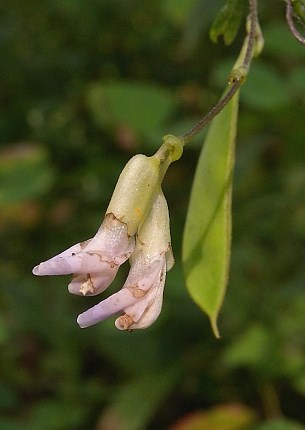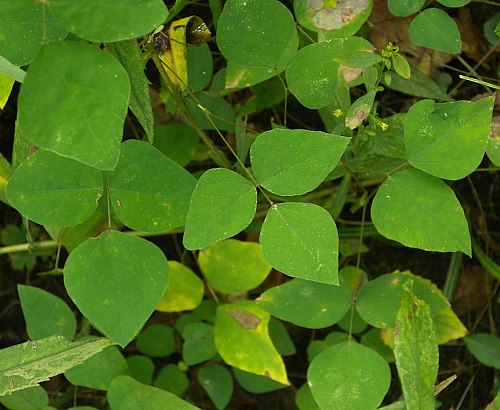 petiole, there is a pair of small stipules
less than ¼" long. Occasionally, congested racemes of 2-15 flowers up
to 2" long are produced from the axils of the leaves. Individual
flowers consist of 5 petals, a tubular calyx with 4 teeth, several
stamens, and a pistil. The petals have a pea-like floral structure
consisting of an upright banner, 2 lateral wings, and
a keel that is
curved upward. The edges of the banner are often folded backward, while
the narrow wings and keel project forward. The petals are light pink,
pale lavender, or white; the calyx is light green to nearly white and
either hairless or hairy. The blooming period
occurs from mid-summer into the fall and lasts about 1½-3 months.
Fertile flowers are replaced by seedpods about 1-1½" long; these
seedpods are oblongoid and flattened with short curved beaks. Each
seedpod contains 1-4 relatively large seeds; individual seeds are
reniform and flattened. In addition to the preceding flowers and their
seedpods, Hog Peanut also produces self-fertile flowers that lack
petals. These inconspicuous flowers are produced on low stolons along
the ground; they mature into single-seeded fleshy fruits with an
obovoid shape. Sometimes, these fruits become subterranean.
petiole, there is a pair of small stipules
less than ¼" long. Occasionally, congested racemes of 2-15 flowers up
to 2" long are produced from the axils of the leaves. Individual
flowers consist of 5 petals, a tubular calyx with 4 teeth, several
stamens, and a pistil. The petals have a pea-like floral structure
consisting of an upright banner, 2 lateral wings, and
a keel that is
curved upward. The edges of the banner are often folded backward, while
the narrow wings and keel project forward. The petals are light pink,
pale lavender, or white; the calyx is light green to nearly white and
either hairless or hairy. The blooming period
occurs from mid-summer into the fall and lasts about 1½-3 months.
Fertile flowers are replaced by seedpods about 1-1½" long; these
seedpods are oblongoid and flattened with short curved beaks. Each
seedpod contains 1-4 relatively large seeds; individual seeds are
reniform and flattened. In addition to the preceding flowers and their
seedpods, Hog Peanut also produces self-fertile flowers that lack
petals. These inconspicuous flowers are produced on low stolons along
the ground; they mature into single-seeded fleshy fruits with an
obovoid shape. Sometimes, these fruits become subterranean.Cultivation: The preference is full sun to light shade, moist conditions, and soil containing sand or loam. The root system of Hog Peanut fixes nitrogen in the soil through the assistance of symbiotic bacteria.
Range & Habitat: The native Hog Peanut is occasional throughout Illinois (see Distribution Map); the two varieties of Hog Peanut, var. bracteata and var. comosa, are about equally common. Habitats consist of floodplain woodlands, low wooded areas along streams, soggy thickets, damp sandy meadows, and seeps. Some disturbance is beneficial if it reduces the shade of canopy trees and other kinds of woody vegetation.
Faunal Associations: The caterpillars of Epargyreus clarus (Silver-Spotted Skipper) and Autochton cellus (Gold-Banded Skipper) feed on the foliage of Hog Peanut. Other insect feeders include the aphid Microparsus variabilis and several leaf beetles: Cerotoma trifurcata, Odontota dorsalis, Odontota horni, Odontota mundula, Odontota scapularis, Phyllecthris dorsalis, and Sumitrosis rosea. Some of these beetles have larvae that mine the leaves. Various vertebrate animals also use Hog Peanut as a food source. Either the seeds or the fleshy fruits of self-fertile flowers are eaten by the Ruffed Grouse, Ring-Necked Pheasant, Bobwhite, Passenger Pigeon (now extinct), White-Footed Mouse, and Meadow Vole; the Ruffed Grouse also feeds on the foliage. To a limited extent, White-Tailed Deer also feed on the foliage.

Photographic Location: Near a stream in sandy woodland at the Indiana Dunes State Park in NW Indiana.
Comments: Sometimes the scientific name is spelled 'Amphicarpa bracteata.' The common name refers to the fleshy fruits of the self-fertile flowers, which are edible to humans. These unusual fruits distinguish Hog Peanut from many other species in the Bean family. Another vine in the Bean family, Apios americana (Groundnut), produces edible underground tubers. These tubers are part of the root system, rather than a modified seedpod. Compared to Hog Peanut, Groundnut has compound leaves with 5 leaflets and its flowers are often reddish brown and less cylindrical in shape. Other vines in the Bean family have differently shaped flowers and their leaflets are usually less broad and rhombic than those of Hog Peanut.